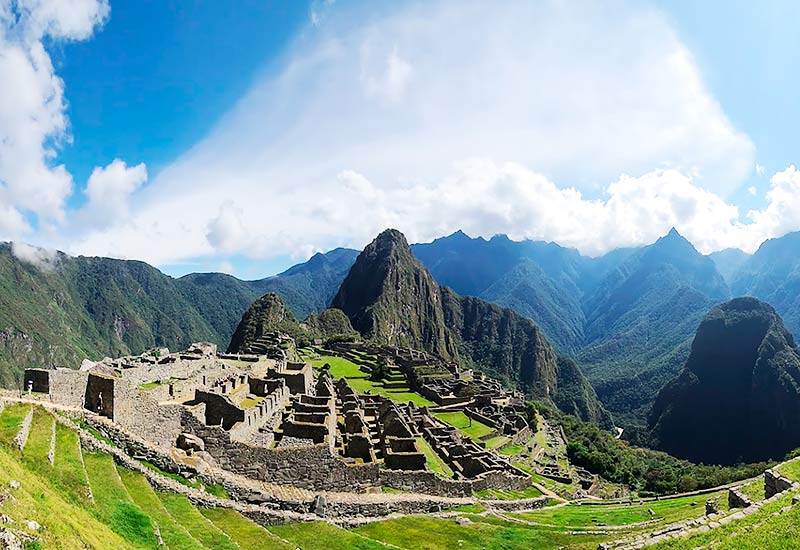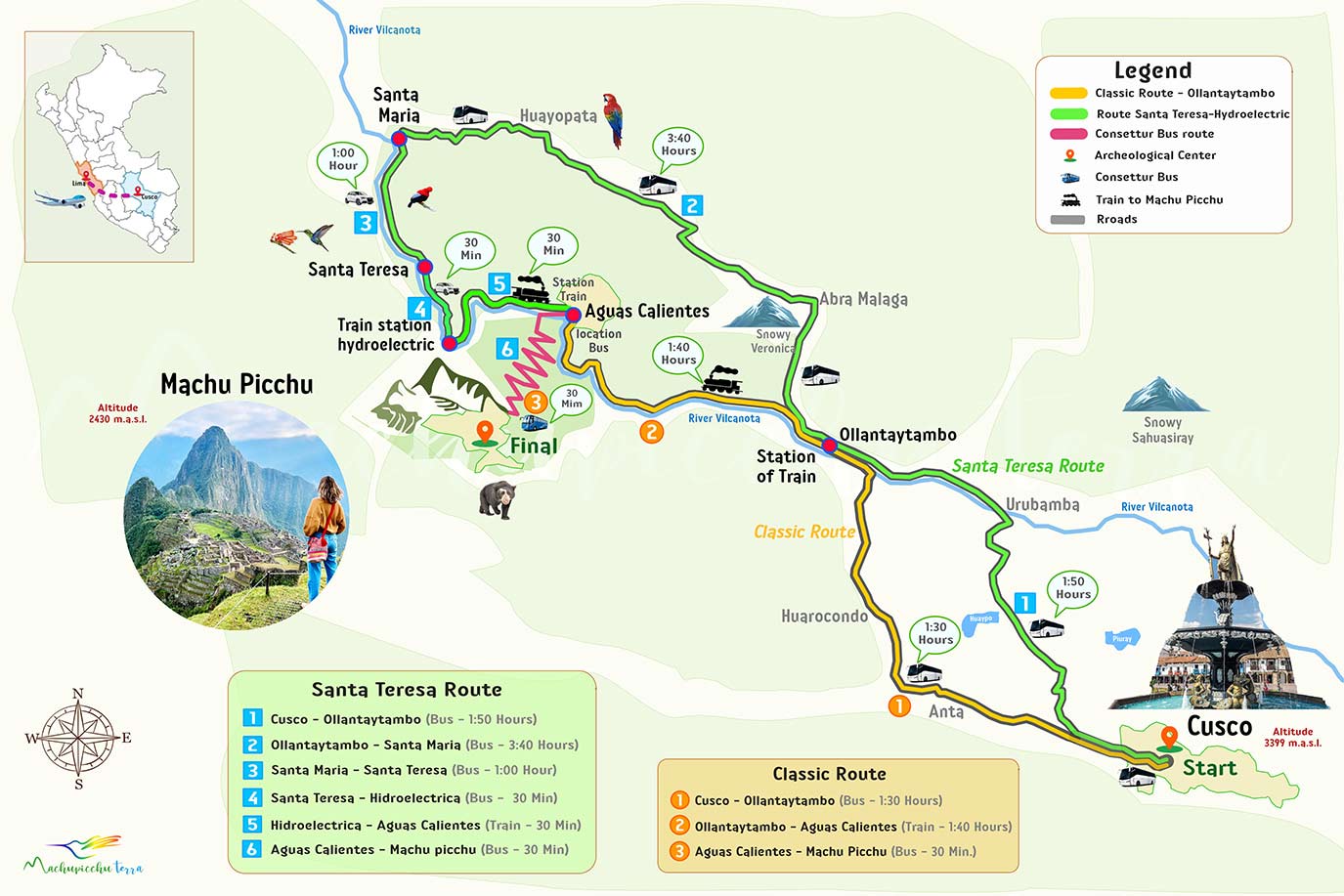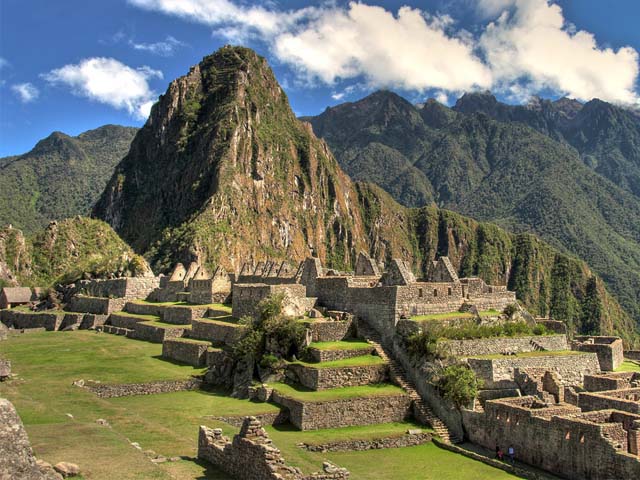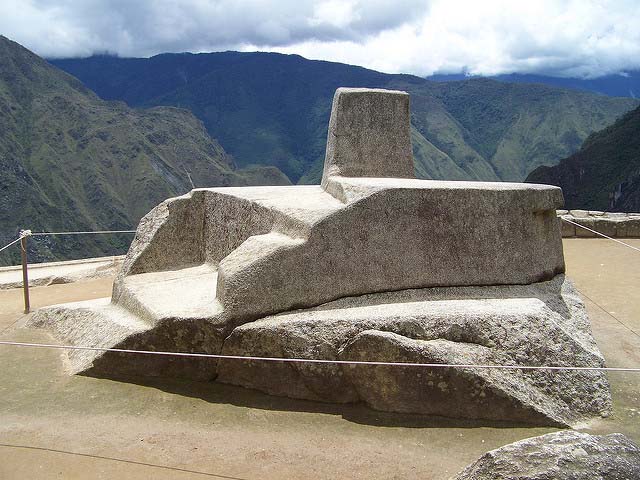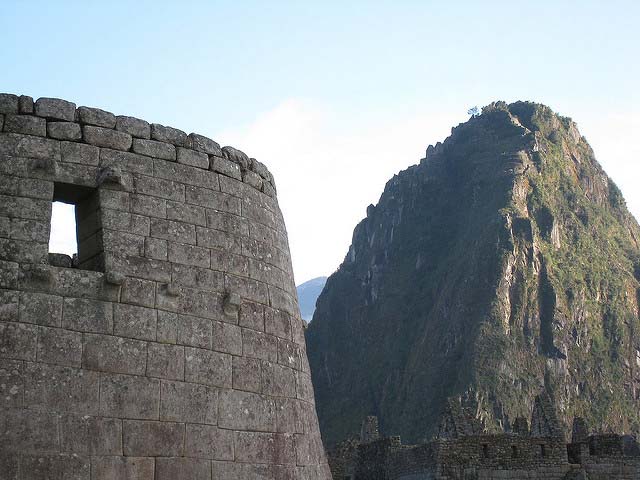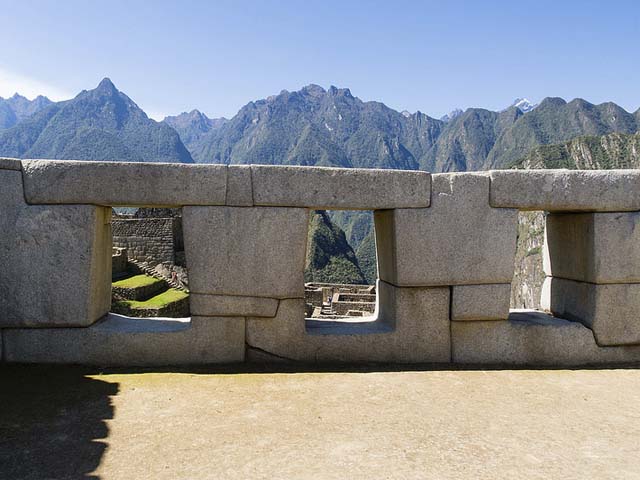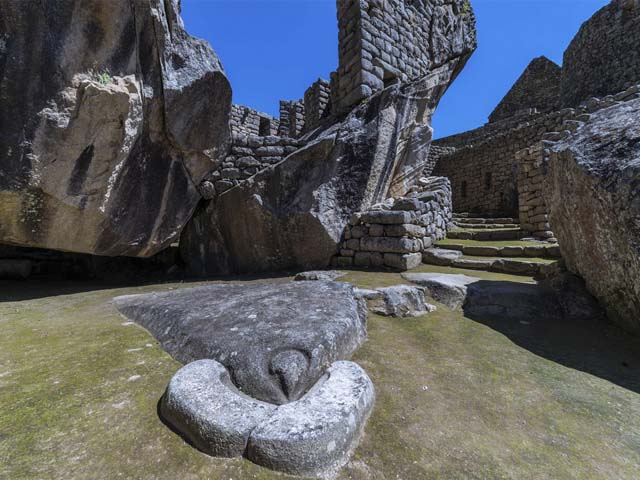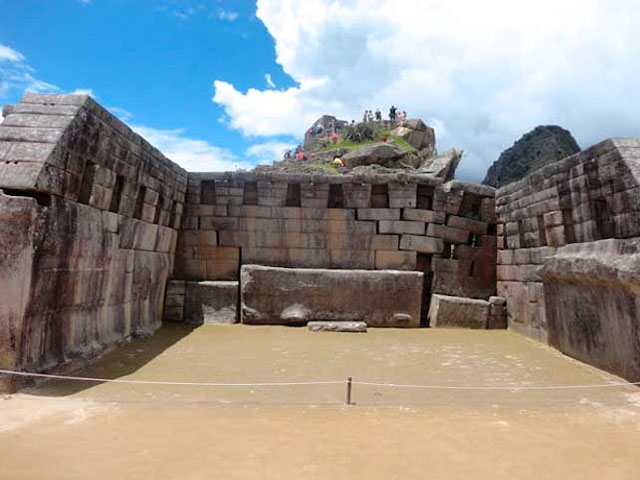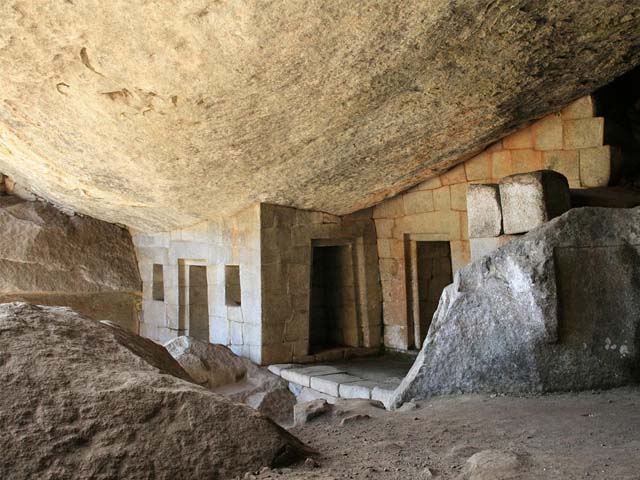Machu Picchu, travel information
Machu Picchu is one of the 7 wonders of the modern world. What is known about this citadel is still being discovered. It was built in about 1450. A.D. under the orders of the emperor Pachacutec. The beauty of the site was not accidental. The Inca ruler sought a citadel that harmonized with his natural environment. After the Spanish invasion in the 16th century, the place was abandoned. Several centuries later, in 1911, the American explorer Hiram Bingham found Machupicchu hidden in the thick vegetation. From that day until today, the history of ‘mapi’ is full of discoveries and mysteries. Today it is one of the most visited sites in the world.
- Why is she so famous?
- Machu Picchu, the emperor’s jewel?
- Machu Picchu situation in 2025
- Where is Machu Picchu located?
- map of the route
- Geography
- Flora and fauna
- What does it mean?
- What’s amazing?
- What to see?
- The mountains: Huayna Picchu and Machu Picchu mountain
- The new mountain Huchuy Picchu
- The circuits in Machu Picchu
- Other things you can do on the trip
- How to get there?
- What is the best time to go?
- Photo gallery
- Some tips for your visit
Why is she so famous?
- Machu Picchu was built as a retirement residence for the Inca and his family. Evidence such as carbon 14 indicates that it was built at the end of the 14th century (around 100 years before the arrival of the Spanish on the continent).
- Machu Picchu is flooded with temples and beautiful residences as well as platforms, water channels and paths to the tops of the mountains.
- The city was designed so that it could be totally self-sufficient and comfortably house its inhabitants, without depending in any way on the outside.
- It had its own crop fields, textile workshops, servants, cattle enclosures, and water throughout the day and throughout the place.
Machupicchu limits to the north with the Huayna Picchu mountain, which allows the visit to the Temple of the Moon. To the south, with the network of roads known as the Inca Trail, the hiking route of 4 days and 3 nights. To the east with the road that leads to the town of Aguas Calientes. And to the west with the road that leads to the Inca Bridge and marked the limits of the Inca city.
Machu Picchu, the emperor’s jewel?
- Machu Picchu was ordered to be built by the famous Inca emperor Pachacutec (1438 – 1471) to be his resting place in a strategic point of the empire: the limits with the tropical jungle of the Amazon.
- Las edificaciones de Machu Picchu fueron construidas en armonía con su entorno natural. Los incas adaptaron las formas de las montañas para construir su ciudad.
- Most of its construction is underground, since they developed a complete irrigation system in order to cultivate plants of different species in various parts.
- In Machu Picchu all kinds of crops were found: from tubers in the highest areas to hallucinogenic plants from the jungle parts of the empire.
- Like many of the most important Inca settlements, it was built on terraces linked by steep paths and stone steps.
Machu Picchu situation in 2025
- After a period of little tourism caused by the Covid 19 pandemic, Machu Picchu once again received thousands of tourists as usual.
- However, as a result of the political instability in Peru, the Inca citadel closed its doors the first days of the year.
- Aun así, Machu Picchu en 2025 continúa recibiendo visitantes procedentes de varios puntos del mundo.
- The political situation in Peru caused fear in some visitors. Despite this, there are still many tourists who come to Peru to fulfill the dream of knowing Machu Picchu.
- All services related to Machu Picchu continue to function normally: transportation by bus, train, tour guide, restaurants, hotels, and entrance to the Inca citadel.
Where is Machu Picchu located?
- Currently, the Inca city of Machu Picchu is located in the district of the same name, in the province of Urubamba, in the department of Cusco, in southern Peru (South America).
- If we take geography into account, Machupicchu is located 2,438 meters above sea level (m.s.n.m.), between the Andes Mountains and the Amazon jungle.
- There are 3 mountains that surround the Inca wonder: the Machupicchu, Huayna Picchu and Putucusi mountains. All these mountains belong to the so-called ‘Batolito de Vilcabamba’.
- Due to its location on top of an inaccessible mountain, Machu Picchu was little known by the Spanish invaders and the nearby settlers, until it became known to the world by the investigations of the American explorer Hiram Bingham in 1911.
map of the route
- By the Ollantaytambo train route – The trip begins with a drive from the city of Cusco to the town of Ollantaytambo, in the Sacred Valley of the Incas (almost 2 hours of travel). Then, you must take a train that will take you to the town of Aguas Calientes (another 2 hours of travel). Finally, you must take a bus to Machu Picchu (30 minutes of travel).
- By the route of Santa Teresa (Hydroelectric) – The route begins in the city of Cusco with the bus trip to the ‘Hidroeléctrica’ train station, crossing the towns of Santa María and Santa Teresa in the jungle of Cusco (almost 5 hours trip). Then you must take a walk of approximately 2 hours to the town of Aguas Calientes. Finally, you take the bus that leads to Machu Picchu in 30 minutes. It is recommended to do this route in a 2-day visit.
Geography
- The geography where Machupicchu is located is characterized by the presence of mountains and snow-capped peaks belonging to the so-called ‘Cordillera de Vilcabamba’, where the imposing snow-capped Salkantay stands out.
- The area has geological faults which generated the abundance of granite stones (which facilitated the construction of the Inca city). Two mountains stand out above the Inca citadel: Huayna Picchu and Machupicchu. Currently, both mountains offer the two most popular hiking trails in the area. Another of the nearby mountains is the ‘Putucusi’. Only 10 kilometers away is the famous town of Aguas Calientes.
Flora and fauna
- Machupicchu has a great diversity of butterflies and birds where the cock of the rocks stands out, recognized as the national bird of Peru.
- There are also some wild animals such as the pudú, the sachacabra, the ucumari, the llama, the vizcachas and the spectacled bear, the latter in danger of extinction.
- Among the species of flowers, the more than 300 species of orchids stand out, without a doubt. This flower is highly appreciated for its beauty and multicolored shapes. Likewise, there are many species of ferns, shrubs and more.
What does it mean?
- The word Machu Picchu comes from the Quechua language (language of the Incas and of many of the current towns settled in the Andes Mountains) which means ‘old mountain’. This name was chosen arbitrarily by the settlers who called the mountain that way.
- However, according to various investigations, the real name of Machupicchu would be ‘Patallaqta’, a Quechua word that means ‘town of the steps’.
- Currently Machupicchu is also the name by which the famous town of Aguas Calientes is known, located at the foot of the Inca wonder. The immense mountain on which the archaeological site is located is also known by that name.
- Likewise, the Peruvians baptized as ‘Machu Picchu’ a famous cocktail made from pisco (a brandy symbol of Peru) and whose presentation combines the colors green, yellow and red.
What’s amazing?
Machupicchu annually receives a little more than 1.5 million visitors. It is true, the fame of the Inca wonder invites tourists from all over the planet. However, what really amazing does Machu Picchu have to offer its visitors?
- The landscapes – Tourists who see Machupicchu for the first time are amazed by the beautiful landscapes that surround the archaeological site. Views include mountains, blue skies (sometimes cloudy), an impressive sidewalk area, trees, and more.
- Energy – Although it sounds surprising, many tourists say they feel a special energy during their visit to Machupicchu..One of the famous attractions for radiating energy is the Intihuatana (solar clock). To do this, you only have to bring your hand closer to this construction. Touching it is currently prohibited.
- The history – The Incas did not have a writing system. Most of its history was written by the Spanish chroniclers who arrived with the conquest. Because of this, everything that is known about the Inca wonder is still shrouded in mysteries. To have a clearer idea of this enigmatic place, it is important to hire a tour guide service.
What to see?
Machu Picchu is impressive: it has temples, residences, platforms, roads and more. Most of these places are included in the tourist route in the company of a guide. To enter others it is necessary to take optional routes, as in the cases of the Intipunku and the Inca Bridge. In other cases, such as the Temple of the Moon, the visit is included in a different ticket (entry that includes the Huayna Picchu mountain).
- The Guardian’s House – Famous construction from where the entire environment of Machupicchu was monitored since it offers a panoramic view of the place. Currently, in this place tourists take the classic postcard photo.
- The intipunku – The famous ‘Puerta del Sol’ through which the Incas entered Machupicchu from Cusco. That is where the sun’s rays were received on the summer solstices. It consists of several walls and windows as well as a main door through which tourists currently enter who make the famous 4-day trek known as the ‘Inca Trail’. Getting to the top from the current entrance to the archaeological site takes approximately 1 hour.
- The Inca Bridge – The Inca Bridge is a rustic construction made of stone that limited the limits of the Inca empire with the east. Faced with a possible threat, the Incas destroyed the bridge to prevent invasions. Currently going there is an optional route that takes approximately 30 minutes. Cross sections close to precipices but 100% safe.
- The intihuatana – This construction is made of a large stone carved into three levels that directly receive the sun’s rays. This solar clock was used to know the sowing and harvest seasons in the place. It is believed that the inhabitants who put their hands close to this construction are filled with the energy that comes from the sun.
- The main temple – The Main Temple is made up of an enclosure with three walls and a main platform as an offering table. It also has windows where ornaments were placed. Earthquakes and the passage of time have damaged these structures, which are uneven.
- The Temple of the 3 Windows – The Temple of the 3 Windows, as its name indicates, is made up of a stone structure with three windows that symbolize the division of the Inca world into three levels: the Hanan Pacha (heavenly world), the Kay Pacha (earthly world ) and the Uku Pacha (world of the dead).
- The Temple of the Condor – This temple is made up of an irregularly shaped rock as well as a stone figure on the ground; which visually united make up a figure of a condor, a sacred bird for the Incas. According to the Inca worldview, the condor communicated the earthly world with the heavenly world of the gods.
- The temple of the Sun – This temple was one of the main religious sites in Machupicchu. It is made of many regularly shaped stones that form a circumference over the top of a cave. It is on the top of the place so it received the sun’s rays inside. Below are some stairs that lead to what would be a royal tomb, due to the relics that were found there when it was discovered.
- The Temple of the Moon – This construction is also known as the ‘Great Cavern’, since it is built inside a cave. It has finely carved walls and windows as well as a kind of altar where sacrifices were supposed to be made. The Temple of the Moon is on the Huayna Picchu mountain, an hour from a fork. Visitors arriving at the temple will find themselves almost alone since few people go there.
The mountains: Huayna Picchu and Machu Picchu mountain
Machu Picchu not only offers temples, enclosures and mysterious Inca buildings. It also includes incredible hikes to its most famous mountains: Huayna Picchu and Machupicchu Mountain. Both routes were traced by the Incas themselves to honor their gods at the highest point of the place. From its summits there are beautiful views of the archaeological site. In addition, you can see abundant flora, fauna and mysterious temples.
- Huayna Picchu mountain – This summit is the one that stands out in the classic postcard photo of Machu Picchu. On its peaks, the Incas built hundreds of stone steps, some of which are close to precipices. That is why the entrance is only allowed to tourists over 12 years old. This adventure is considered an exciting experience. You can also visit mysterious constructions such as the Temple of the Moon. Admission is with the ticket “Machu Picchu + Huayna Picchu Mountain or Wayna Picchu (Route 3A).”
- Machu Picchu Mountain – This imposing mountain is the location of the Machu Picchu archaeological site. Its name was taken from the Inca city, although it is believed its true name was Patallacta. On the mountain, the Incas carved paths ascending to its summit. From there, you have the highest view of the Inca complex. You can also observe a diverse range of flora and fauna. Admission is open to visitors of all ages and is available with the “Machu Picchu + Mountain (Route 1A)” ticket.
- The Huchuy Picchu – Machu Picchu mountain has opened a new adventure route: the hike to the top of Huchuy Picchu Mountain, located 2,497 meters above sea level. From there, you have a scenic view of the Inca archaeological site. This mountain belongs to Huayna Picchu. Unlike Huayna, the hike to Huchuy Picchu Mountain is easy. It takes only 30 minutes to reach its summit. The route is along Inca stone steps. The entrance ticket is called “Machu Picchu + Huchuy Picchu (3D Route),” which allows you to complete the third circuit of the Inca archaeological site.
The new mountain Huchuy Picchu
Machu Picchu has opened a new adventure route: the hike to the top of the Huchuy Picchu mountain, whose top is located at 2,497 meters above sea level. From there you have a landscape view of the Inca archaeological site. This mountain belongs to Huayna Picchu.
Unlike the ‘Huayna’, the hike to the Huchuypicchu mountain is simple. It takes only 30 minutes to reach its top. The route is through Inca stone steps. The entrance ticket is the ticket called ‘Machupicchu + Huchuypicchu’, which allows circuit 4 through the Inca archaeological site.
The circuits in Machu Picchu
Depending on the ticket to Machu Picchu that you choose, you can do one of the three available circuits:
Circuit 1 – Panoramic
Ideal for those seeking a stunning visual experience, this circuit offers four routes that ascend to the highest points of Machu Picchu. Along narrow paths, visitors access breathtaking landscapes that surpass even the classic postcard view of the citadel. Each route presents a different level of physical challenge, but all reward with unparalleled views of Inca architecture and perfect harmony with the natural surroundings.
Circuit 2 – Classic Route
This circuit is perfect for those who wish to explore both the agricultural terraces in the central part of Machu Picchu and the urban area. Through two moderately demanding routes, you’ll visit buildings that served as homes, ceremonial sites, and astronomical observation areas. It’s the best option for a balanced mix of history, architecture, and physical activity.
Circuit 3 – Royal Route
Designed to explore the most iconic sites associated with the Inca nobility, this circuit includes four access routes to sites such as the Temple of the Sun, the House of the Inka, and the Temple of the Condor. The basic version involves light physical exertion, making it an ideal option for those seeking a more relaxing experience. However, if you choose to complement the tour with the ascent of Huayna Picchu, Huchuy Picchu, or the hike to the Great Cave, greater physical fitness is required.
Other things you can do on the trip
In addition to the adventure routes through its mountains and its archaeological site full of buildings and history, on the trip to Machu Picchu the tourist can visit other amazing places. For example, one of the most important attractions in the region is the 7 colors mountain, also known as the ‘Vinicunca’. Likewise, the tourist can visit the city of Cusco, the Sacred Valley or take the Inca Trail.
- The city of Cusco – The capital of Cusco has innumerable tourist attractions and options for the visitor. Its most famous archaeological sites are Sacsayhuaman and the Coricancha. Its museums, churches, culture and its nightlife are also attractive. There are most hotels, restaurants, bars and tourist services.
- The Sacred Valley of the Incas – This set of towns and geographical areas was an important place for the Incas who built citadels and palaces such as Pisac, Ollantaytambo and Chinchero. The salt mines of Maras and the circular platforms of Moray are also famous. Today, the tourist can perform various types of adventure sports in the Sacred Valley.
- The mountain of 7 colors – The Vinicunca is the second most popular tourist attraction in Cusco, after Machupicchu. It is a natural mountain located more than 5,000 meters high (16,400 ft). Due to a natural mineralization process, the mountain has various colors that resemble a rainbow. However, on days of intense cold and rain, snow partially covers the place.
- The Inca Trail – According to the tourists who made this trek of 4 days and 3 nights; there is no better way to get to Machu Picchu. In total, each tourist travels 39 kilometers along the ancient roads made by the Incas and that connected Cusco with Machupicchu. The entrance is through the Puerta del Sol (Intipunku).To do this walk, yes or yes, you must hire a tour online 5 or 6 months before.
How to get there?
To get to Machupicchu you can choose some of the only 3 access roads:
- The train trip through Ollantaytambo – This short train route is one of the most incredible out there. Walk through the beautiful landscapes of the Sacred Valley of the Incas until you arrive at Machu Picchu. Most visitors use the minivan route from Cusco to Ollantaytambo and from there by train to Aguas Calientes. In this town you take a bus or walk up to the entrance gate of Machupicchu.
- The bus trip through Hidroeléctrica – This little-known route begins in Cusco, crosses high Andean landscapes and ends in the town of Aguas Calientes, in the jungle of the region. The route begins in the city of Cusco from where you take a bus to the town of Santa María. Then the route continues to the town of Santa Teresa and, from there, to the Hydroelectric station. Finally, you must continue on foot or by train to Aguas Calientes, at the foot of Machu Picchu. In total the route can take 6 or 7 hours.
- The route of the Classic Inca Trail – This hiking route covers a section of the Inca road network that connected Cusco with Machu Picchu. Each visitor will walk 39 kilometers for 4 days and 3 nights of camping until arriving at the Inca city through the Puerta del Sol (ancient entrance route used by the Incas). There is an alternative route of only 2 days called ‘Short Inca Trail’.
What is the best time to go?
- During the year, Machupicchu has two distinct seasons: the dry season (from April to October) and the rainy season (from November to March). The first is characterized by the scarce presence of rain and clouds. The second, due to the greater frequency of rain and cloudiness. The months with the most intense rains are January, February and March.
- According to visitors who have already been to Machupicchu, the best time to go is during the dry season (April to October). In those months, the days are sunnier and with less possibility of rain. This makes it possible to take the best photographs of the Inca city. For many, May, June and July are the best months to visit.
Some tips for your visit
- If you visit Machupicchu on your own, you can buy your tickets online. Tickets are sold on the website of the Ministry of Culture of Peru. You can also make your purchase through the website of an authorized tourism agency.
- Machupicchu is 2,430 meters above sea level. At this altitude, the symptoms of altitude sickness (also called soroche) are less intense, such as fatigue, nausea and excessive agitation when making physical exertion. To lessen these symptoms, avoid alcoholic beverages and greasy foods.
- Within Machupicchu, the use of umbrellas, baby carriages and shoes with heels is prohibited. Instead, the visitor must bring a rain poncho, a backpack-type baby carrier, and slippers. In addition, selfie sticks and drones are prohibited.
Advice from people who have been there
 By: De: Laura G
By: De: Laura G“without words“
“I could say that Machu Picchu is amazing, incredible, astonishing, mystical, impregnable, mysterious, energetic; but they are only words that I write, because Machu Picchu left me speechless. They have to see it.“
By Ticket Machu Picchu – Last updated, March 31, 2025
